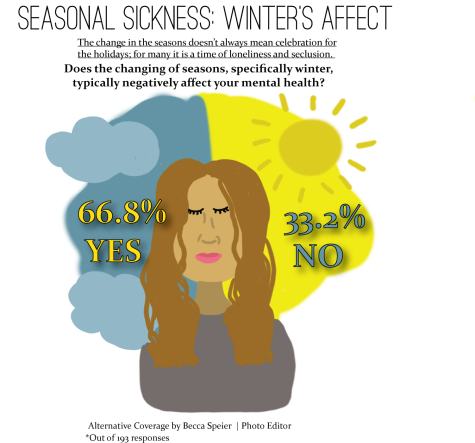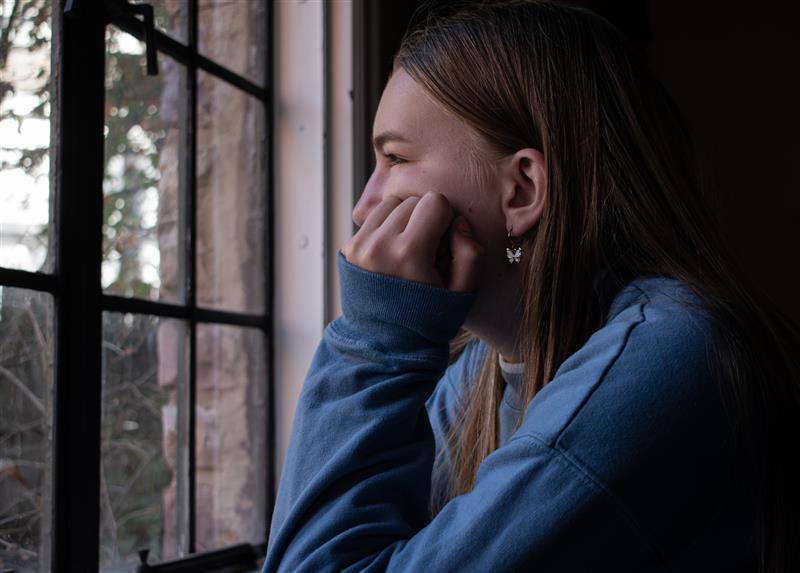The perfect storm: pandemic, winter weather create mental health challenges
Between the COVID-19 pandemic, circadian rhythms being disrupted by winter and general mental health issues, depression and other mental disorders are predicted to rise this winter.
November 21, 2020
At the end of August 2019, sophomore Taylor Hayes felt overwhelmed by the change of workload that comes with highschool and juggling her efforts to become more involved at school along with theater, her freshman year. She went to counselor Amanda Whitcomb for help.
“One time specifically I went into Whitcomb’s room just to cry,” Hayes said. “And she let me. And it was really nice. She didn’t ask any questions, she just let me cry and that’s what I needed in that moment which was really nice.”
Hayes has noticed the effects of mental health around her, especially during the uncertainty caused by the COVID-19 pandemic. Based on her experiences during the winter months in the past, she has come up with specific coping mechanisms, such as cleaning, baking, and cooking.
Seasonal depression or SAD (Seasonal Affective Disorder) is a mood disorder characterized by depression that occurs at the same time every year. It happens in climates where there is less sunlight at certain times of the year and affects more than 3 million people in the US per year. Some symptoms of SAD include fatigue, depression, hopelessness and social withdrawal according to the Mayo Clinic. Hayes believes that the winter months paired with COVID-19 could be very damaging to many peoples’ mental health.
“[I]t’s dark all the time,” Hayes said. “And I know that sunlight already makes you happy — scientifically, sunlight makes you happy.”
According to Time, the brain has higher serotonin levels on sunny days and lower levels on cloudy days. Decreased sunlight in the winter is a major factor in SAD. Whitcomb also recognizes the effects of daylight savings time and less sunlight on mental health.
“[When] the sun goes down earlier, our circadian rhythm is affected,” Whitcomb said. “…Recognizing that our behaviors and our mental and emotional well-being is affected by changing the seasons, by weather, by the sun going down earlier, the moon phases and all kinds of different things can affect our behavior, as I understand it, so that would be more of a seasonal depression.”
According to Boston University Today, an estimated 5% of the population suffers from SAD. A recent study found that the prevalence of depression symptoms was more than 3 times higher during the COVID-19 pandemic than before. Combined with rising COVID-19 case numbers in nearly all metropolises in the United States, some experts predict that general depression rates may rise this winter. Precautions imposed to prevent the spread of COVID-19 have proved to be a challenge for Hayes.
“I think social distancing might have been the hardest for me,” Hayes said. “It was just hard for me to grasp, for me to be like, this is my life now.”
Senior Izzy Bryars has also been challenged by social distancing and limiting the number of people she sees.
“I was suppose

d to go to like a Halloween thing on Saturday, and it was too many people,” Bryars said. “I just decided not to go because I’m trying to be conscious of [social distancing]. It’s for my family, also, like my grandparents and stuff, because my mom sees them a lot.”
While being mostly in-person has benefitted some students, Whitcomb still has seen trends in the deterioration of students’ mental health being linked to pandemic precautions.
“I find students are feeling very isolated, a lot of students I work with who are very social, who enjoy being around their friends are really struggling [being] isolated,” Whitcomb said. “For a small few it’s been helpful, for others, I would say the majority, it’s really tough to be in quarantine.”
With free time during the stay-at-home order, Hayes thinks that social media use has gone up exponentially, and it has also become a negative factor for her mental health. To combat this, in June, Hayes decided to take a month-long break from social media and found it benefitted her mental health significantly. Hayes would recommend taking a break from social media to everyone and says it helped her find who she was closest too.
“My big thing is friendships because I feel like that’s the only thing that’s been getting me through everything,” Hayes said.“…The people that reached out to me over quarantine when I didn’t have any social media are the people that I’m closest to now.”
Bryars has also noticed a correlation between using social media more and her mental health. Turning “do not disturb” mode on has been her method to reduce screen time and distractions from social media.
STA has many resources for those struggling with seasonal depression such as group counseling, individual counseling with either Whitcomb or Gajewski, outside services that come in such as Resolve and Sources of Strength. The counseling department is also happy to provide information about other outside resources such as personal therapy or medical care if that’s what a student needs. Whitcomb says that although a school’s resources can never be completely exhaustive; she tries her best to help students as much as possible.
“My hope is that if a student comes to see me, they have a strong sense of self, just a feeling of comfort when they come in and when they leave,” Whitcomb said.
Whitcomb recognizes that there are many resources and methods to help, so it is important for students to find what works for them.
“If you recognize within yourself that this seasonal piece is really hard for you, set some stuff up in advance, make sure you have some different events that you can attend if you’re someone who needs to be connected, even if it’s a virtual event,” Whitcomb said. “And if you know that you really struggle to be alone, maybe you can schedule a weekly call with a friend. There’s a lot of different things that you can do to keep your mind and your body busy. Exercise is also really important during this time.”
Whitcomb also offered mental health practices that could mitigate the effects of SAD or general sadness and anxiety.
“So, [it’s] really being aware of what you can do within yourself,” Whitcomb said. “You know, watch a fun series on Netflix, get up and go for a walk, if you can’t go outside and exercise, do a YouTube Zumba video, do something to keep you engaged and active, and then continue to reach out…And so, we as individuals have to find what works for us and if you don’t know what works for you, let’s talk about it. Come and see someone like me to talk about what you have done in the past, what doesn’t work, let’s eliminate those [and] come up with something new.”
Although Bryars has not utilized STA’s counseling or mental health resources, she still believes being on campus at STA has improved her mental health.
“I just really appreciate how much they did to make it possible for us to be open,” Bryars said. “And I think that was like, the best thing they could do for girls, mentally was to, like, put all these precautionary practices in place, and then, make it possible for us to go because I can only imagine being completely virtual right now.”
With being on campus, some students may still feel isolated or alone. Whitcomb thinks it’s essential to reinforce the importance of connection.
“The reality is that no one is alone in this pandemic piece, right?” Whitcomb said. “We are all in the pandemic together.”
